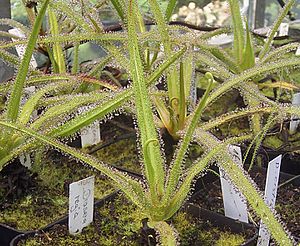King sundew facts for kids
Quick facts for kids Drosera regia |
|
|---|---|
 |
|
| Several plants in cultivation | |
| Scientific classification | |
| Kingdom: | |
| (unranked): | |
| (unranked): | |
| (unranked): | |
| Order: | |
| Genus: | |
| Subgenus: |
Regiae
Seine & Barthlott
|
| Species: |
D. regia
|
| Binomial name | |
| Drosera regia |
|
| Synonyms | |
|
|
The King sundew, officially known as Drosera regia, is a fascinating carnivorous plant. This means it eats insects! It belongs to the sundew family. You can only find this special plant growing naturally in two spots in one valley in South Africa.
Its leaves are very long, reaching up to 70 centimeters (about 27 inches). The King sundew has some unique features. It has a woody rhizome, which is like an underground stem. It also has special pollen that is covered. Scientists have studied its genetics and found that D. regia is one of the oldest types of sundews. Interestingly, it shares some traits with the Venus flytrap. This suggests they might be related.
Contents
How the King Sundew Catches Food
The leaves of the King sundew are covered with sticky "tentacles." These tentacles are actually special glands. They produce a very sticky mucus that looks like dew drops. This sticky substance helps the plant catch large insects.
Trapping Prey
The King sundew is an active "flypaper trap." When an insect like a beetle, moth, or butterfly lands on a leaf, it gets stuck in the sticky mucus. The plant's tentacles then slowly wrap around the prey. This traps the insect completely. The plant then digests the insect to get nutrients it needs.
Where the King Sundew Lives
In the wild, D. regia grows in marshy areas. It competes for space with other plants. These include native marsh grasses and small evergreen shrubs.
Endangered Status
There are only two known groups of King sundews left in nature. One group, found at a higher altitude, has become overgrown. D. regia no longer grows there. The other group, at a lower altitude, has only about 50 mature plants.
Because of this, the King sundew is the most endangered type of Drosera. It is at risk of becoming extinct in the wild. Many people who love carnivorous plants grow D. regia to help protect it. There is even a special type grown by people called "Big Easy."
Images for kids
See also
 In Spanish: Drosera regia para niños
In Spanish: Drosera regia para niños





